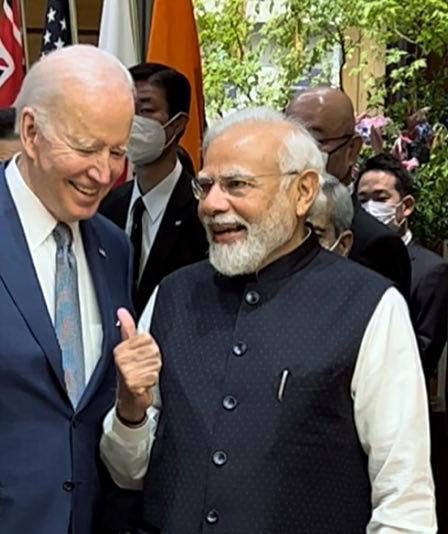WASHINGTON, DC: Beijing in late November said it was opposed to joint Indian and American military exercises conducted about 100 kilometers south of the Line of Actual Control, the de-facto boundary between India and China, in India’s Uttarakhand, at Auli.
For nearly two weeks,Indian and American troops were improving, among other things, their ability to work alongside each other, during the 18th edition of the YudhAbhyas drills.
YudhAbhyas, the Chinese said, violated the spirit of two Sino-Indo border agreements, from 1993 and 1996. New Delhi, of course, ignored the Chinese pronouncement.
As India should.
“It is more imperative than ever for the Indian and USmilitaries to increase and intensify their operational and tactical training against the People’s Liberation Army along the India-China border,”James Fanell, a retired USNavy captain, who served as director of Intelligence and Information Operations of the USPacific Fleet, told The Sunday Guardian.
Despite Chinese objections, India and the United States are developing a close military relationship. In December, for instance, India’s elite Marine Commando Force MARCOS trained with USNavy special warfare operators on the other side of India, in Goa.
Moreover, India’s forces are working with the militaries of the region’s other democracies. India along with Japan, Australia, and the United States participated in the Japanese-hosted naval Malabar 2022 drills in November. AsJapanese Maritime Self-Defense Force Rear Admiral IkeuchiIzuru said, “this exercise embodied the firm and united will of the four countries toward the realization of a free and open Indo-Pacific.”
There is one country standing in the way of a free and open region: the People’s Republic of China. Beijing has expansive—and legally questionable—claims to large portions of neighbouring countries, especially India, as well as clearly unsupportable claims to the South China Sea and other peripheral waters.
Chinese expansionism led to the formation of the Quad, the group of four states participating in Malabar 2022.In the first and second decades of this century, Japanese leaders proposed that regional democracies band together to contain a militant China. Then, these proposals, like Shinzo Abe’s Democratic Security Diamond and Taro Aso’s Arc of Freedom and Prosperity, went nowhere as countries, deluding themselves,were optimistic about “engaging” China.
Since then, however, Chinese ruler Xi Jinping’s “wolf warrior” diplomacy hasmade neighbouring states reconsider engagement and pushed themto work together to protect themselves.As a result, the militaries of the Quad countries regularly exercise with each other. In short, Beijing essentially created the Quad and other coalitions now arrayed against it, both in the Indo-Pacific region and elsewhere.
India is in the Quad primarilybecause of Prime Minister Narendra Modi—the opposition Congress party has traditionally been especially friendly toward China—but there are still lingering disagreements and different points of view. The country that has put the most distance between itself and the others in the grouping is India.
New Delhi has always seen itself as non-aligned, and it maintains long-standing links to Moscow, now a close partner to a China thatthreatens India’s territorial integrity. The large Chinese incursion in Tawang in Arunachal Pradesh in December 2022, plus the clashes in the Galwan river valley in Ladakh beginning in May 2020 are only the most recent reminders of Beijing’s intent to break apart India.
China’s increasing belligerence—20 Indian troopers were killed in a Chinese surprise attack in Galwan in June 2020—mean that, over time, India will move closer to the other three Quad members—and further from Russia.
The issue is not India’s direction, but time. New Delhi and the region are on the clock. As Fanell, now at the Geneva Center for Security Policy, points out, the increasing violence of the Chinese regime suggests Xi Jinping is in a hurry. “Time is not on the side of ‘business as usual’,” he says. “India and America should work urgently to establish interoperability.”
In the not-so-distant past, warnings from Beijing, like the one over the joint exercises in Uttarakhand, madeUS officials tremble. These days, Americans are more inclined to ignore harsh Chinese words and work with friends, because Americans are getting ready for what they know will almost certainly come as China tries to realise territorial ambitions.
Washington policymakers once thought of US-China ties as “the world’s most important bilateral relationship.”
Now, the tone of comments has changed. The Biden administration, like predecessors, would still like to work with China, but as efforts havecontinued to fail there is a realization in Washington that Americawill have to work with democratic partners and not the totalitarian Chinese regime.President Joe Biden’s Democracy Summit, in December 2021, was an important step in building the coalition of free states that Abe and Aso envisioned.
For the United States, there is no more an important democratic partner than India, the world’s most populous free society.
For that and other reasons, India is fast becoming America’s choice.
Gordon G. Chang is the author of The Coming Collapse of China. Follow him on Twitter @GordonGChang

